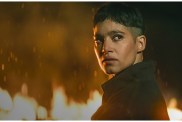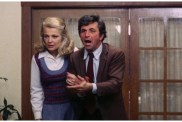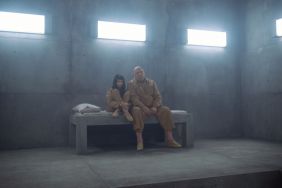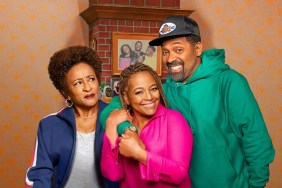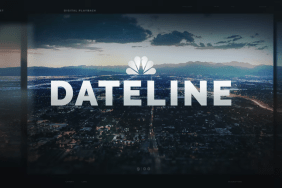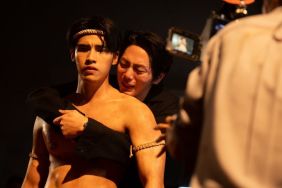On Super 8, Prometheus and his aesthetic process

There’s a real good chance that you’ve seen something designed by Neville Page the last few years when you stepped into the movie theater.
The artist is responsible for sundry movie monsters, and other creations, such as the giant beast that rampages through New York City in Cloverfield, the hungry fish of Piranha 3D, the otherworldly creatures of Avatar, Star Trek and Green Lantern, or, the alien visitor of this summer’s Super 8. Thanks to the latter’s forthcoming DVD and Blu-ray release, the opportunity sprung up to be able to speak to Page about the film and his career. Being such a fan of the concept design process myself, I jumped at the chance to pick the man’s brain about his previous works and the directors he has worked with, including Ridley Scott. Yes, Page contributed to the super-secret Alien prequel, Prometheus.
Shock Till You Drop: As your body of work builds, I think it’s becoming easier to recognize a bit of your styleâ¦
Neville Page: I’ve been told that. I personally try to avoid that…
Shock: Apologies then…
Page: Oh, it’s certainly not an insult. It’s one of those things where I don’t see myself as an artist who is trying to develop a “look” as a personal vision. I see myself as an arm, hired to realize other peoples’ visions. Yes, they hire me because I have a particular take on things and aesthetic. Working with someone like James Cameron, Ridley Scott or J.J. Abrams, they have an agenda, they have a vision they need my help realizing. So, the reason I say I try to have my style come through is because it’s not about me, it’s about taking whatever is in their heads and trying to bring it to light. It ends up being infused with your aesthetic propensities. You can’t help to have it be of you. It’s my job to make sure the character in their production doesn’t look similar to something else in another production.

Initially, it seemed like it might have been more difficult at the very beginning when I was going to be working for J.J. and Steven. But Steven knew this was J.J.’s movie and let him make the decisions. He advised and looked at stuff whenever J.J. wanted his input. When we would show designs of the creature, he would have an opinion that was based on what he knew was coming out in other productions â particularly Cowboys and Aliens – so, he was able to guide those two productions. I gave a presentation and his notes were, “Do this and do that and make this small change. And the reason why is because I don’t want it to look like the creature from Cowboys and Aliens.” I was like, interesting! We have somebody on the inside!
Shock: You’ve worked with a lot of big guns at this point â Scott, Abrams, Cameron, Spielberg. How do they differ from one another in the design process?
Page: There are significant differences and, creatively, you can see the end result. Different directors put focus on different things. Some will focus more on story, character, d.p. choices. Michael Bay â who I haven’t worked for â focuses on digital FX. There’s that. What’s interesting is the style in which they deal with their artists. Three positive differences between Cameron, Ridley and Abrams⦠With Cameron, he knows exactly what he’s looking for and he’ll tell you what you need to do. He still gives you the freedom to come up with alternative solutions. But the direction is clear and that’s a positive thing for an artist. With J.J., he likes the artist to have greater freedom, initially, even though he has a strong idea of what he wants. He lets you run out of the gate and do whatever. Obviously, here, we needed an alien designed, but he’ll says, “I need two arms, two legs and a head. That much I need and he’s about 12 feet tall.” That’s great in itself because then you have the freedom to do what you want. But that’s scary because your blank page will remain blank a bit longer than usual because you’re left to your own devices. Scott it right between the two where he gives you freedom, but he also knows what he wants. Ridley, one day, busted out a Sharpee and, as he’s talking, he’s doodling and after a few minutes, he had an image drawn that was not only a great piece of art, but communicated what I was supposed to do. There was also room for interpretation. I’ve been very fortunate to have worked with these guys.

Shock: Was there ever a conversation during the Super 8 design process about finding that fine line between making a monster that was too scary and one that wasn’t?
Page: It comes down to holding the reins, but holding them loose and finding that delicate dance between gore versus horror versus fear. When you draw something, you can readily see if it works or doesn’t work. You can look at the proportions and say it looks dumpy and silly, or it looks skinny and frail. At the beginning, I was drawing something was long and attenuated and not powerful enough. What one does is look for that perfect balance in silhouette that sums up the “quick read.” In the film, you don’t get a good look at the creature, so you have to have something that will quickly convey this goal. I had many conversations, too, with probably all of the directors I’ve worked with. The default with making a creature scary is teeth being exposed, pinks gums and furrowed brow. That’s easy to do. That’s primal. You see that and you know you’re scared. I like to do the opposite. I like to design the creature with its mouth closed in a neutral scenario, because it’s easy to make something scary. If you look at a female lion sleeping, that’s not a scary animal, but it’s a cat and it’s furry. When it needs to be, it can be horrific.

No. I was not invited back. I was surprised that there was no call. That’s not out of ego, but I’m surprised no one from the original was called back. The politics of it are what they are. But when you see a title like Piranha 3DD, oh boy, maybe it’s good you didn’t get that call back. I did see some images of the fish, it doesn’t look like they changed much.
Shock: Your plate has to be pretty full right now with Star Trek 2, anything else coming up?
Page: Well, the big finish for me was Prometheus.
Shock: Did you get to work alongside H.R. Giger at all?
Page: Saddest thing. No. Didn’t see him, didn’t hear his voice. I honestly do not know if he was involved in the production. For me to have met Giger would have been such a huge thing. I hope he’s invited to the premiere and I get to shake his hand. To have worked on the film is ridiculous. Crazy ridiculous. Everything I get to do it incredible and good fortune. To take multiple films of Ridley’s that had such an impact on me, and then sit in a room and work with him on a project that is near to his heart and have him like what you do, I felt like a young boy because dad was approving of my efforts. It was damn stellar.
Shock: Being a fan of Abrams’ Star Trek, it’s nice to see he’s taking his time with the sequel and not rushing it.
Page: He’s only going to do things when they are right, which is the reason you haven’t seen Cloverfield 2 yet. Hopefully, it won’t be called Cloverfield 2DD. And if it does, they don’t need to call me! [laughs]
Be sure to visit Page’s official site at NevillePage.com where you can find more of his work.
(PHOTO CREDIT: Nikki Nelson / WENN.com)
Source: Ryan Turek, Managing Editor

